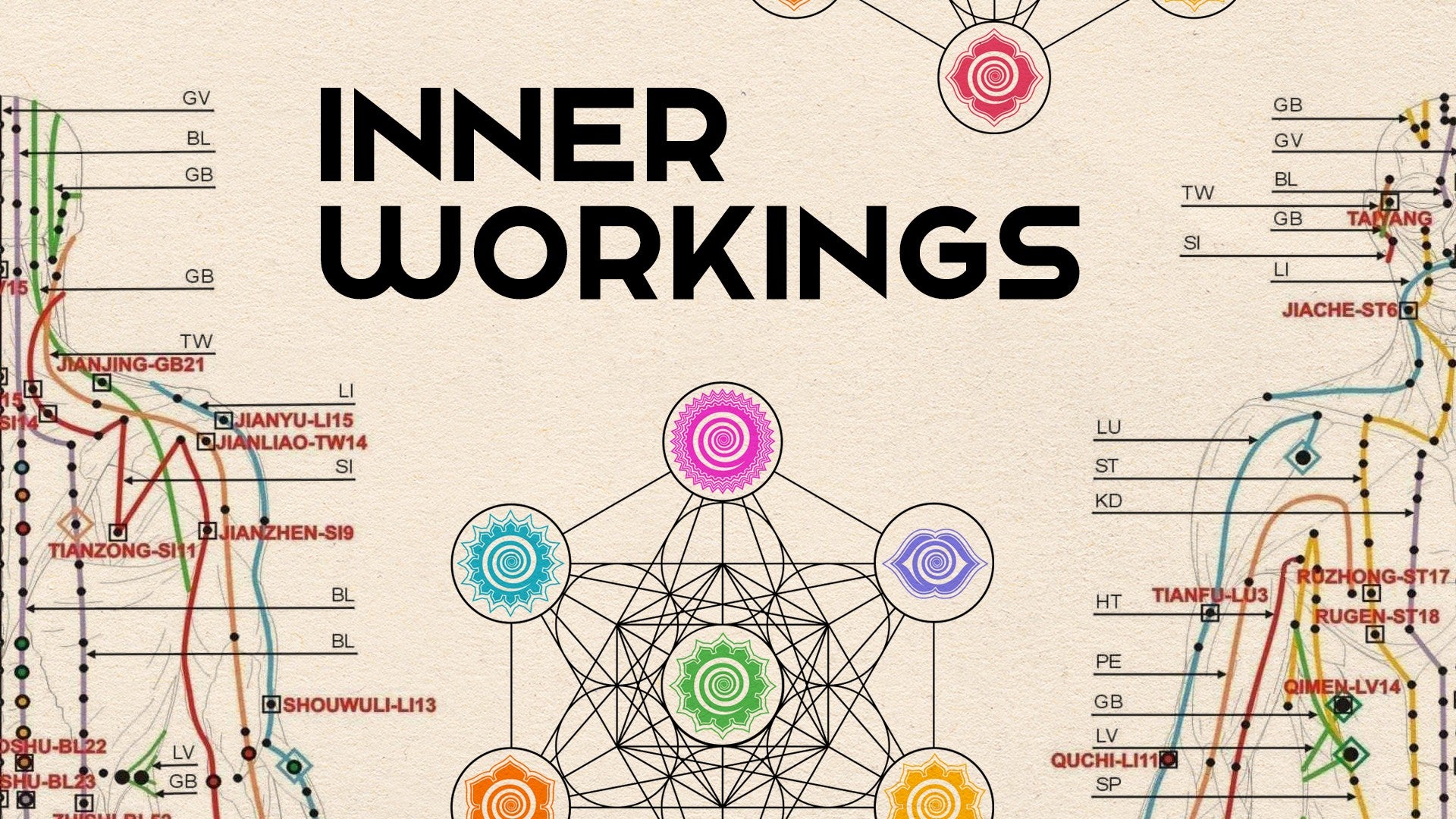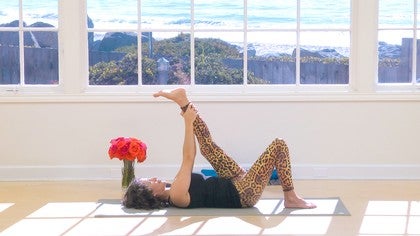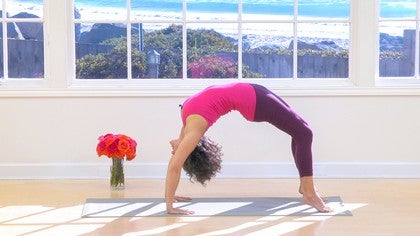Description
About This Video
Transcript
Read Full Transcript
(waves crashing) So there's a taste to everything. Not just your food, your thoughts. Thoughts can be sweet, thoughts can be salty. Thoughts can be sour, thoughts can be bitter. The play is to start to know these tastes, okay, so one of the purposes of pratyahara is to become more sensitive to what we're doing.
So in this sequence, we'll be exploring the realm of the mouth, and particularly the tongue. The yogis say that the tongue is the sense organ of the svadhisthana, or sacral chakra, and the rumor is the root of the chakra is in the lower sacrum, and it flowers into the lower belly. So our play in this sequence will just move through a simple sequence of movements with awareness on allowing this area to stay soft and open, and then we'll take this into a meditation experiment with the hope that we might be able to more easily find a soft mouth, and therefore more easily find the kind words we always wished we had said. So we're going to start sitting. You might be in a chair, I'm on the earth, or on a wood floor, you might be somewhere else.
I'm choosing to sit with my heels in line with each other. You could be in a variety of positions. I'm going to suggest that you hold on to your knees, inhale, and as you exhale, hold on to the knees, curl the sit bones under and let yourself get round, and as you inhale, roll the pelvis forward and let your heart lift. Okay, continue, so hold on to the knees as you exhale get round, curling the sit bones under, and as you inhale, roll the pelvis forward letting your heart arch. Okay, continue, exhale, get round, inhale roll the pelvis forward, draw your heart up.
Again, the purpose of these practices of yoga are to help increase our capacity to get into it, to get into the life, not to avoid it. Couple more moments. Now, next time you allow the pelvis to roll forward, feel the pelvis roll forward, feel the heart open. Now the temptation here is to harden in the lower back. So with the heart open and the pelvis forward, let a little ah happen, and soften in the sit bones, and just start to wiggle them forward.
Some of you might let your hands come gently out in front of you, some of you might walk them way out in front of you. Okay, so my pelvis is rolling forward, my heart is lifting, a little bit of a ah. Okay, so some of you, this might be deep enough, some of you your hands might come all the way forward. Let your elbows bend, that can be really super nice, palms up. Nice, okay, chin into the chest, roll them back up.
Do that on the other side. Heels in line with each other, same idea, hold on to the knees, inhale, exhale roll back, and now roll forward, exhale, roll back. Now, the reason to hold on to the knees is because it just gives you a little bit more, and it creates a relationship. In that relationship, when you really feel like you're holding on to something, you can go out further, when you really feel the support of something, you can lift up. Okay, now I've got a particular pace, yours might be faster or slower.
Again, remember, we're playing on the rumor that the svadhisthana sits down here in this lower sacrum, lower belly. So we're just helping to open this area. Okay, I think maybe one more, and then we'll be about even. So you roll the pelvis forward, you draw the heart open. This might be the perfect spot, but the suggestion here is let a little ah happen so the sit bones drop.
Hands are going to come out in front of you, and again, some of you might walk your hands quite far forward, some of you not very much. Back of the neck is long, this might be the perfect spot. If you choose to come forward, again, your hands might walk way out. Today I'm going to choose to let my elbows bend, palms up, I'm just letting it round. Nice.
Okay, super nice, let yourself come all the way back up. So we've gotten a little bit of sense of opening in the sacrum. Now, the second point for us to start to tune is this region of the mouth. Okay, so big deliberate inhale, exhale, let a ah happen, and soften down in the low belly, soften down in the pelvic floor. Heart is generous.
And usually as you start to find the alignment of your skull, usually as you start to find her, the tension already starts to dissipate. The area where most of us are most queued in to the tension is the jaw, so let your awareness come into the jaw, okay, so the hinges. As your awareness comes into the jaw, if you're having trouble bringing your awareness there, you can use your hands to gently touch the area. As your awareness comes in to your jaw, can you start to have a sense of spaciousness here. Let the bottom hinge of your jaw start to get heavy.
Okay, so as we're going to say something, it sounds like this, it's getting heavy. As that gets heavy, right, start to notice the region of the gums, start to become more aware of the gums, and for real, notice how you can let your gums soften. Okay. Notice how you can let your teeth lose some of their bite. Notice how even your teeth can feel lighter, yeah.
Now, start to become aware of the tongue, like, start to become aware of where she sits in the mouth, how she's sitting in the mouth, and can you let her feel fluffier? Feel if she feels constricted, can you let her just feel more relaxed? Notice where she seems to want to be. Notice, is the tip of her resting on the lower teeth or upper teeth? Upper palate softens.
Really become so fascinated with this, like really, and you'll notice that the jaw's already gotten tense again, soften again. Throat soft. Okay, so this, this softness here, this is our point of focus. This is in this next just simple sequence what we're going to keep coming back to reminding you. As we've talked about, it's one thing to be able to soften your jaw when not much is going on.
It's another thing in the daily life. With this as the focus, let the soles of the feet find each other, in a simple boddha konasana. Kind of wobble a little bit. Okay, big deliberate inhale, exhale, let a ah happen. The play from boddha konasana is we're going to make our way towards pigeon on a revolving side angle, stretch on one side, and then on the other, and then we'll come back and do a meditation.
I'm going to remove this blanket. Let your, lean to your left, let your right leg come behind you. And you're coming into pigeon pose. We've explored pigeon pose together before. Okay, so you're salting to taste.
However far you want this heel away from you to make it more intense, or closed to make it more gentle. You might place a blanket underneath your hip if that would feel good. Take the time to kind of snuggle in here, and see what's happening. Big deliberate inhale, exhale, let a ah happen. As you sink down into the hip, tune towards softening the jaw, softening the gums, softening the mouth.
Okay, easy. We're going to be here for maybe about two and a half minutes, so some of you are going to stay right here, okay, this is ideal. Some of you are going to walk your hands a little bit more forward. This might be perfect, okay really, you're a sophisticated yogi, so just trust, okay, what feels right. The key, though, is to continually use the jaw, the tongue, and the softness here as your barometer.
Okay, nice. Let the low belly relax, and as the low belly relaxes, can you notice the corresponding opening across the sacrum? As the low belly relaxes, and you notice the corresponding opening in the sacrum, can you also feel your tongue more open? We're exploring maps that have been given to us by our yogi friends. Easier in the mouth and the tongue, easier in the eyes.
If it's not so easy, there's a lot of other thoughts trying to grab your attention. The discipline here, or the dharana, or the study of tension is to just practice coming back to this one single point. Back to this one single point, nice. Nice. Just about another half minute.
Again, I'm showing up on my elbows, you might have a different position. Beautiful, okay. Now, as you're getting ready to come out of this, you're going to bring your hands underneath the shoulders, the chin is going to come into the chest, and you're going to roll on up. We're going to revolve so that we end up in the position for revolving head to knee pose. Extend this right leg out, bring this left foot in, and a little different than janu sirsasana, where you're at a slightly more obtuse angle, okay.
Snuggle in, inhale here, exhale, let a ah happen en route. Again, just let your primary focus be the jaw, mouth, and tongue. Okay, right hand down onto that right leg, circle the left arm in front of the face and up. Soften the elbow, okay, reach up through this left arm, let this side lengthen, let the underside open, and then let that elbow bend so that you can start to reach up, out and over a little bit. Now, what's the taste?
Can you soften the low belly, can you let your sacrum widen, and can you sensitize yourself, can you taste this a little bit? Okay, so for some of you, this is deep enough. Okay, you are in there, not me, so as you prefer to deepen this situation, to allow the elbow to bend maybe, in fact, that might feel good. Let that top elbow bend so that you can allow your heart to lift a little bit more, so you can leave a little, excuse me, move a little bit more into the revolve, easy in the jaw, easy in the eyes. As you bend that top elbow, that shoulder becomes a little bit of an altar for the heart.
Then once you've revolved, you can reach again, nice. Okay, take a look down at that extended leg, let an inhale bring you all the way back up and pause, soften the jaw and the mouth, nice. Now, the transition is to pigeon on the other side. So since we're already pretty well set up, you can just let that knee bend, let that other leg extend back, and snuggle in towards pigeon. (soft chuckles) Maybe you're using that blanket behind you, and again, the key here, right, the key, because there are a lot of things we could focus on, okay, like we could focus on anatomical details, we could focus on the breath.
We're using the shape to help us focus on the continual vigilant attempt of the mouth to do all the work, so right away, just notice the jaw probably clenched up, like, soften, soften the gums, soften the teeth, soften the tongue. And for many of you, staying right here is deep enough, and if pigeon is really not your bag, it's not everybody's medicine, you could find yourself into what we usually call reverse pigeon or eye of the needle. Okay, only once you have the green light, you might come forward, you might come down onto the elbows, and now here, remember the relationship of the sacral chakra, so soften the low belly right where, according to our yogis, the flower of the svadhishthana blossoms, soften the low belly and just see if anything occurs in the sacrum. The element that the yogis associate with this area is water, so as you soften the low belly and you let the sacrum open, can you soften the jaw and feel more fluid in the tongue? Yeah, again, I'm showing up on my elbows.
You might be propped up or have your hands, your head resting on your hands in a different way. These easy, beginning openings assume that you have a little bit of experience now on the mat, that you know how you like to move, and we're using them as gateways more into the subtles, so my alignment instructions will be spare. Okay, nice. Beautiful, not much longer now, just a few more moments. Excellent, so when you come out, you let the hands come underneath the shoulders, you're going to roll on up.
We're going to revolve towards that revolving head to knee position, extend out through that extended leg. Okay, sole of the foot in the inner thigh. Snuggle in, big deliberate inhale, exhale let a ah happen, and soften the jaw. This is the focus, this is what we're becoming good at, right? The focus of this is not to become good at opening up the side waist.
That's a side effect, that's a side benefit. Okay, left hand down on that left leg, circle the top arm up, soften the elbow so the shoulder is relaxed, back and down. Reach a little bit, okay, jaw, open up through the underside, and then only as it's appropriate for your body, let the elbow bend, let yourself start to reach over. Okay, gooey in the back of the neck. Again, for some of you this is the perfect spot.
Some of you might be dipping a little bit lower. What we played with on the other side, we'll play with that again. If you let your elbow bend, and you allow your shoulder blade to drop under into that hallelujah arm style that we often explore, that will give you a little bit of that altar to be able to rotate a little bit more, to be able to start to allow for some rotation, okay, as you reach, and what you do with your head, some of you it'll feel good to drop your head, some of you it'll feel good to turn your head. This feels particularly good this morning. Lengthen, soften the jaw.
Nice, okay. I'm going to look down at that leg on the earth, inhale, let yourself come all the way up, and pause. Nice. The last piece of our sequence before we move into our meditation experiment, bring the soles together one more time in boddha konasana, but let them be slightly in front of you. I'm just going to move this blanket out of the way so I have room.
The suggestion now is to bring your hands behind you. So, as you bring your hands behind you, you might put your fingertips to point straight back. That has one quality, and it's generally nicer on the wrists, but some of you it might feel okay to turn your fingertips forward. That's a little bit more difficult in the wrist. Today, actually, it's feeling like I want to turn my fingertips back.
I'm sort of surprised by that, but I go with it. Roll the pelvis forward, let your heart lift, and many of you will stay right here as you kind of wobble a little bit, soften the jaw. Keeping the chin dropped is the safest for the neck. Starting to let the throat open, starting to let the face brighten can feel really good, and a couple of you might press into the feet, and you start to lift your hips up. So you press into the feet, you start to lift your hips up, and you're wobbling, and you might let your head fall back.
Okie dokie, let your hips come back down, and let your heart lead, and you come back up. Okay, set yourself up for a successful seat. I'm going to set up on this blanket. I'm going to bring my heels in line with each other, okay. So, what we're hoping is that there's been some experience of continually coming back to softening the jaw.
In this meditation experiment, we're going to allow ourselves to bring a real life situation in to play with the experiment. So, step one, big deliberate inhale, exhale, let a ah happen, and soften the low belly, soften the pelvic floor. You've done a little opening in the hips, let them relax, let the heart feel generous, and let the mind feel light. Nice. Step two, tune back in to the softening.
Easy in the jaw hinge, open in the gums, fluffy in the tongue. Start to become, start to let this ease be more the norm. Nice, okay. Now here's the play, stay with this, and the request is, is that most likely, okay, most likely, there's somebody in your life with whom you're always having fake, imagined conversations. Someone in your life who you're always like, and in those kind of fake, imagined future conversations, there's a harshness.
Okay, most likely, you have somebody like this in your life, if not, that's amazing. Awesome job. But the play now is, is to allow this person to come into your meditation, allow this person to be with you, and if you need to put them 100 yards away or under a glass jar, you do that, but now, let yourself, hear yourself, let yourself internally start to have this conversation. These usually happen in the shower, but I'll do it here. And as you've allowed yourself to do this now, please notice what's happened in your jaw, what's happened in your tongue, what's happened in your mouth.
Please notice what's occurred here, what's happened in the low belly. Okay, study. Okay, nice, relax that situation, poof, clear. Big deliberate inhale, exhale everything. Soft in the belly, soft in the heart, and in the jaw, okay.
Sometimes it can help to be like -- (blowing with lips together) That helps a lot. (soft chuckling) Here's the play. Of course, if that's pleasurable and you want to continue that, go for it, okay. But what I find, more and more, I find that if I'm paying attention, if I'm paying attention, my imagined future conversations are so often defensive, and anticipatorily, like, righteous. Then when I'm in my retro communication, my redoing those conversations, and you're making yourself out to be a better person than maybe you are, I'm infinitely kind and compassionate and way funnier.
The play here is to, like, begin to loosen the grip of this imagined future tension. Okay, so here's the next step of the meditation. We're going to do the same thing, we'll set up, we'll soften the jaw, okay. As we bring this other being into the meditation, you know, you might notice the effect, but the request is, it's not like you're not trying to have those words, you're not trying to keep yourself from having the conversation, but can you put the awareness on just opening the jaw, relaxing the intensity. I mean, let's try.
Okay, last part, you're doing awesome. Snuggle in, big deliberate inhale, exhale everything, let a ah happen. Soft in the belly, soft in the lower back, soft in the pelvic floor. Generous, receptive heart, aligned mind. Tune to the softness in the mouth, like, spacious in the jaw.
As you feel your gums soft, you might even imagine they're more pink, like younger, like drop the bite in the teeth, fluffy in the tongue, let this be really important. Now the play is, can this be your reference point? So maybe it's the same person, or maybe it's a different one. Bring this being into your field, let them be as close or as far as they need to be for you to feel safe. We're not trying to not say the words, but instead of trying to block your language, can you let this being be here, and can you simply soften the jaw?
Soften the tongue. Soften the bite, like, let this be the focus. Okay, a few more moments just noticing, just noticing if there's any effect. Sometimes there's nothing more to say. Rarely, rarely do we regret not saying something.
Okay, relax the project, big deliberate inhale, exhale everything. Let yourself sit here for as long as feels correct, continuing to practice letting this soften. So sweet to be in these experiments together. Namaste.
Inner Workings: Sensing the Self
Comments
You need to be a subscriber to post a comment.
Please Log In or Create an Account to start your free trial.











